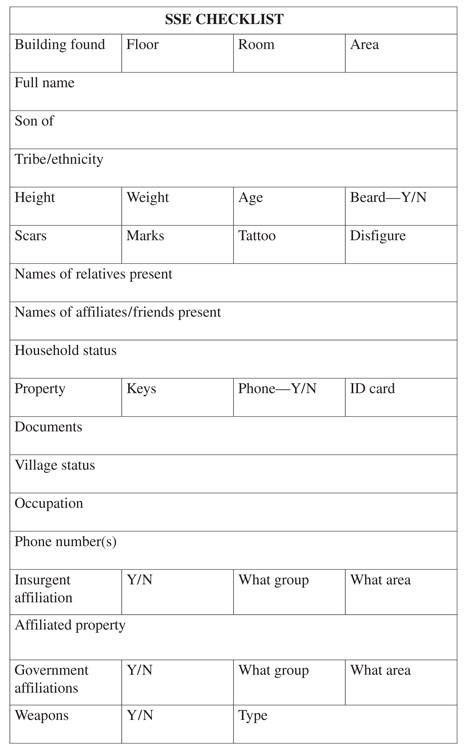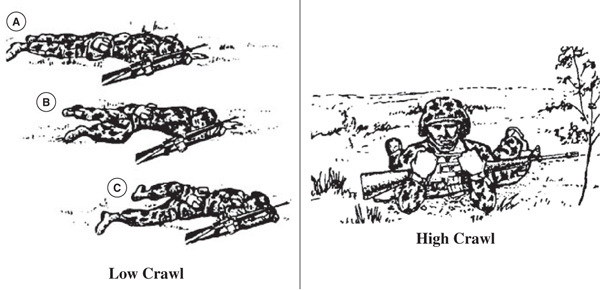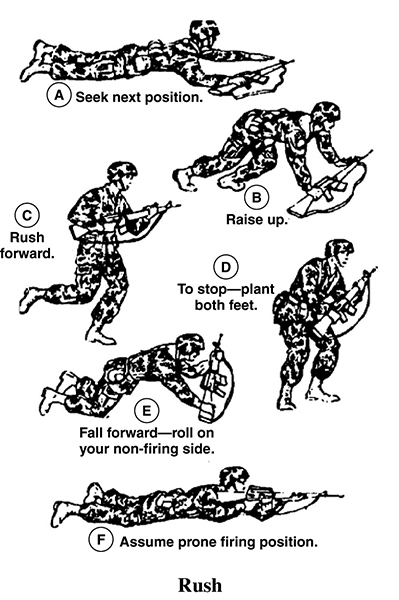The following is a list of thirteen questions that a leader can use on an objective to begin the process of determining what persons are of interest. These questions should be the first ones you ask:
What is your name?
What is your father’s name?
What is your grandfather’s name?
What tribe/ethnicity are you?
What are you doing here?
What are the names of the other people here?
What tribe/ethnicity are the other people?
Where are the other people from?
Why are the other people here?
Where are they going?
How long have the other people been here?
Are there any weapons or explosives here?
Where are any insurgent/anticoalition forces?
Sensitive Site Exploitation
The following is a processing checklist that will aid in the organization of the sensitive site exploitation (SSE) of a target.

Identification
Before evacuating an EPW, attach a tag to him showing the date and time of capture, place, capturing unit, and circumstances. Use the above template to coordinate and track EPWs.
HANDLING CAPTURED DOCUMENTS AND EQUIPMENT
Enemy documents and equipment are good sources of information. Documents may be official (maps, orders, records, or photos) or personal (letters or diaries).
If such items are not handled properly, the information in them may become outdated. Give them to your leader quickly. Tag each item with information on when and where it was captured. If it was found on a PW, include the PW’s name on the tag.
16
Individual Movement and Security
As a member of a fire team you may have to get close to an enemy position using the correct individual tactical fire and movement techniques dictated by METT-TC. All movement needs to be coordinated with other team or squad members in order for each of you to provide cover for one another.
MOVEMENT SKILLS
Observe the following practices during movement:
•Camouflage yourself and your equipment.
•Tape your dog tags to each other and to the chain to prevent rattling. Tape or pad loose parts of your weapon and equipment so they do not rattle or get snagged. Jump up and down. Listen for rattles.
•Do not carry unnecessary equipment.
•Stop, look, and listen before moving. Be especially alert when birds or animals are alarmed, as this is a sign the enemy may be nearby. Look for your next position before leaving your current one. Look for covered and concealed routes on which to move.
•Change direction from time to time when moving through tall grass.
•Use battlefield noises to conceal your movement noises.
•Cross roads and trails at places that have the most cover and concealment (large culverts, low spots, curves, or bridges).
•Avoid steep slopes and places with loose dirt or stones.
•Avoid cleared, open areas and tops of hills and ridges.
INDIVIDUAL MOVEMENT TECHNIQUES
After analysis or orders, determine the correct individual movement technique(s) for each individual movement forward.
Low Crawl
Select the low crawl when the route provides cover or concealment less than 1 foot high, visibility provides the enemy good observation, and speed is not required. The proper way to do the low crawl is (A) to keep your body as flat as possible to the ground. Hold your weapon by grasping the sling at the upper sling swivel, letting the handguard rest on your forearm and the butt of the weapon drag on the ground, thus keeping the muzzle off the ground. Move forward (B) by pushing both arms forward while pulling your right leg forward, and then pull with both arms while pushing with your right leg (C). Continue these push-pull movements until you reach your next position, changing your pushing leg frequently to avoid fatigue.

High Crawl
Select the high crawl when the route provides cover and concealment, poor visibility reduces enemy observation, and speed is required but the terrain and vegetation are suitable only for the low crawl. The proper way to do the high crawl is to keep your body off the ground while resting your weight on your forearms and lower legs. Cradle your weapon in your arms, keeping its muzzle off the ground. Keep your knees well behind your buttocks so they stay low and move forward by alternately advancing your right elbow and left knee, and left elbow and right knee.
Rush
Select the rush when you must cross open areas and time is critical. The proper way to do the rush is to move from your firing position by rolling or crawling because the enemy may have your current position identified. Start from the prone position and select your next position by slowly raising your head. Lower your head while drawing your arms into your body, keeping your elbows down, and pulling your right leg forward. Raise your body in one movement by straightening your arms and springing to your feet, stepping off with either foot. Run to the next position, keeping your distance short and trying not to stay up longer than three to five seconds. At your position, plant your feet and fall forward by sliding your right hand down to the heel of the butt of your weapon and break your fall with the butt of your weapon. Roll or crawl to a covered or concealed firing position.

STEALTH
To move with stealth, use the following procedures:
1.Hold your rifle at port arms (ready position).
2.While stepping, make your footing sure and solid by keeping your body’s weight on the leading foot.
3.Raise the moving leg high to clear brush or grass.
4.Gently let the moving foot down toe first, with your body’s weight on the rear leg.
5.Lower the heel of the moving foot after the toe is in a solid place.
6.Shift your body’s weight and balance to the forward foot before moving the rear foot.
7.Take short steps to help maintain balance.
NIGHT MOVEMENT
When moving through dense vegetation, avoid making noise. Hold your weapon in one hand and keep the other hand forward, feeling for obstructions.
When going into the prone position:
1.Hold your rifle with one hand and crouch slowly.
2.Feel the ground with your free hand to make sure it is clear of mines, trip wires, or other hazards.
3.Lower your knees one at a time, until your body’s weight is on both knees and your free hand.
4.Shift your weight to your free hand and opposite knee.
5.Raise your free leg up and back, and lower it gently to that side.
6.Roll quietly into a prone position.
When crawling at night:
1.Crawl on your hands and knees.
2.Hold your rifle in your firing hand.
3.Use your nonfiring hand to feel for and make clear spots for your hands and knees to move to.
4.Move your hands and knees to those spots and put them down softly.
FLARES
If you are caught in the light of a ground flare, move quickly out of the lighted area. The enemy knows where the flare is and will be ready to fire into that area. Move well away from the lighted area, and look for other team members. If you hear the firing of an aerial flare while you are moving, hit the ground (behind cover, if possible) while the flare is rising and before it illuminates the area.
The sudden light of a flare may temporarily blind both you and the enemy. To protect your night vision, close one eye while the flare is burning.
If you are caught in the light of an aerial flare and you can easily blend with the background (in a forest), freeze in place until the flare burns out. If caught in the open, immediately crouch low or lie down.